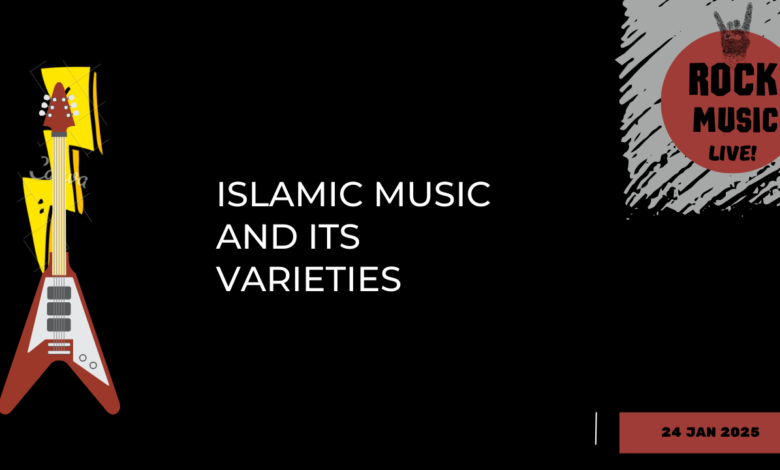
Islamic Music and Its Varieties
Islamic music refers to a wide range of musical traditions and genres that are influenced by Islamic culture, spirituality, and history. It includes various forms of music used for religious, cultural, and artistic expression within the Muslim world.

Introduction
Music has always played a significant role in the cultural and spiritual expression of various societies around the world. In the Islamic world, music holds a unique place, reflecting the rich diversity of cultures and traditions within the Muslim community. Islamic music encompasses a wide array of styles and genres, each offering a unique glimpse into the spirituality, history, and artistic creativity of Muslim societies. In this article, we will explore the varieties of Islamic music and their cultural significance.
Quranic Recitation
At the heart of Islamic music is the Quranic recitation. The Quran, the holy book of Islam, is recited in a melodic and rhythmic manner known as “Tajweed.” This melodious recitation is not only a religious practice but also a form of music deeply embedded in Islamic culture. Quranic recitation serves as a means of spiritual connection, and the unique melodies employed vary from region to region, reflecting the diverse musical traditions within the Muslim world.
Also check.
- Who is the Wessiah in Islam?
- What is Wudu in Islam?
- What is Jihad in Islam?
- Why did Islam Spread So Quickly?
- What are the Holy Books of Islam?
Nasheed
Nasheed, also known as Islamic songs or chants, is a genre of Islamic music that has gained immense popularity in recent years. Nasheeds typically convey religious themes, spreading messages of faith, devotion, and moral values. They are performed in a capella or with simple instrumental accompaniments and are often used in religious gatherings, weddings, and celebrations. Nasheed artists use their musical talents to inspire and uplift the Muslim community.
Qawwali
Originating in the Indian subcontinent, Qawwali is a captivating form of Islamic music characterized by its energetic and soul-stirring performances. It features a lead vocalist, harmonium, tabla (drums), and sometimes other traditional instruments. Qawwali artists sing Sufi poetry and spiritual verses, aiming to create a sense of spiritual ecstasy and closeness to God among the listeners. The legendary Nusrat Fateh Ali Khan is one of the most renowned Qawwali performers, whose music transcended cultural boundaries.
Andalusian Music
Andalusian music is a fascinating blend of Islamic, Jewish, and Christian musical traditions that flourished in Spain during the medieval period when much of Spain was under Muslim rule. This genre combines classical Arab music with local influences, resulting in a rich and diverse musical heritage. Andalusian music reflects the intercultural exchanges that occurred in the region and serves as a testament to the coexistence of diverse religious and cultural communities.
Sufi Music
Sufism, a mystical branch of Islam, has its own unique musical tradition. Sufi music often incorporates repetitive chants and melodies, creating a trance-like state among participants. Whirling dervishes and Sufi orders use music and dance as a means of achieving spiritual enlightenment. The poetry of Rumi and other Sufi mystics is frequently set to music, emphasizing themes of love, unity, and spiritual awakening.
Regional Variations
Islamic music is not a monolithic entity; it varies widely across regions, reflecting local customs, languages, and musical traditions. For example, in North Africa, the Gnawa music of Morocco combines Islamic spiritual themes with African rhythms, while in Turkey, classical Ottoman music offers a unique blend of Islamic and Central Asian influences.
Conclusion
Islamic music, in all its diverse forms, serves as a powerful medium for expressing faith, spirituality, and cultural identity within the Muslim world. It embodies the rich tapestry of Islamic history, highlighting the artistic and spiritual contributions of the Muslim community to the global cultural landscape. From the mesmerizing Quranic recitation to the soul-stirring Qawwali and the transcendent Sufi music, Islamic music continues to resonate with both Muslims and non-Muslims alike, offering a window into the beauty and depth of Islamic culture and spirituality.

FAQs
What is Islamic music?
Islamic music refers to a wide range of musical traditions and genres that are influenced by Islamic culture, spirituality, and history. It includes various forms of music used for religious, cultural, and artistic expression within the Muslim world.
What role does Quranic recitation play in Islamic music?
Quranic recitation is a fundamental aspect of Islamic music. It involves the melodic and rhythmic recitation of verses from the Quran, serving both as a religious practice and a form of music deeply rooted in Islamic culture.
What are Nasheeds?
Nasheeds are Islamic songs or chants that convey religious themes, moral values, and devotion. They are often performed in a capella or with simple instrumental accompaniments and are commonly used in religious gatherings, celebrations, and weddings.
What is Qawwali music, and where did it originate?
Qawwali is a captivating form of Islamic music originating in the Indian subcontinent. It features energetic performances with a lead vocalist, harmonium, tabla (drums), and other instruments. Qawwali artists sing Sufi poetry and spiritual verses to create a sense of spiritual ecstasy.
What is Andalusian music, and why is it significant?
Andalusian music is a blend of Islamic, Jewish, and Christian musical traditions that developed in Spain during the medieval period under Muslim rule. It reflects the intercultural exchanges of the time and showcases the coexistence of diverse religious and cultural communities.
What role does Sufi music play in Islamic spirituality?
Sufi music is an integral part of Sufism, a mystical branch of Islam. It often features repetitive chants and melodies that induce a trance-like state among participants. Sufi music and dance are used as a means of achieving spiritual enlightenment and expressing themes of love, unity, and spiritual awakening.




